Mazda Titan
| Mazda Titan | |
|---|---|
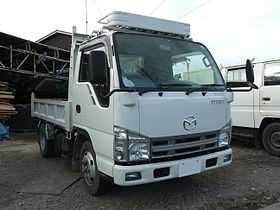 | |
| Overview | |
| Manufacturer |
Mazda (1971-2000) Isuzu (2000-Present) |
| Production | 1971-present |
| Assembly | Fuchu, Hiroshima, Japan |
| Body and chassis | |
| Class | Truck |
| Body style | Truck (standard cab, crew cab) |
| Related |
Isuzu Elf Mazda Parkway |
| Powertrain | |
| Transmission | Mazda (manual), Aisin (automatic) |
The Mazda Titan is a commercial truck produced by Japanese automaker Mazda since 1971. From the fourth and sixth generation model, the vehicle had become a rebadged Isuzu Elf truck.
Predecessor
Mazda's original entry into the mid-sized truck class was the Mazda E2000 of January 1964. This, in turn, had replaced the earlier D-series. The E2000 came with a standard bed ("EVA12"), with a three-way dropside bed ("EVA12S"), and as a long-wheelbase dropside ("EVA32S").[1] The truck had a 81 PS (60 kW), 2.0 litres (1,985 cc)
(VA) which had also been used in the earlier D2000.[2] At the time of introduction, the production target was 1,900 units per month.[3] In 1970 a version called the E2500 was added to the lineup. It was fitted with the Perkins-developed "XA", a 2.5 litres (2,522 cc) diesel engine which produces 77 PS (57 kW). It's chassis code is "EXA".[2]
First generation (1971–1980)
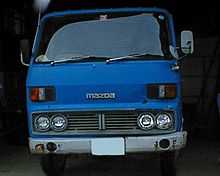
The first Titan was presented in 1971, as a successor to the two-ton Mazda E2000.[3] The box-section chassis rails were unusual for the class.[4] Receiving the chassis code "EXB", the tilt-cab Titan retained the 2.5 litre "XA" diesel engine of the earlier E2000 without any change.[2] For heavier duty usage, there was an also the XB-engined Titan T2700: a 2.7 litres (2,701 cc)
diesel version with four more horsepower (81 PS or 60 kW). A 2-litre petrol four was also available. In 1977, the Titan underwent a minor change and facelift. Along with a new grille and bumpers, the turn signals were bigger and more squared off and incorporated vents for the cabin. Most obviously, the old round "M" logo was replaced by the new corporate "MAZDA" logo.
The larger, 3.7 litre XC-engine also became available for heavier yet versions, offering 100 PS (74 kW). This generation Titan was also the first to provide the basis for the Australian-market 3-tonne truck badged "Ford Trader".[4]
Second generation (1980–1989)
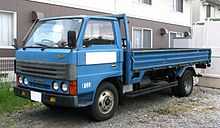
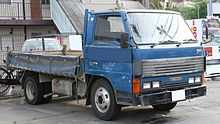
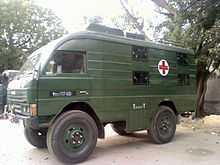
1980: Announced the second generation. The engine capacity increased to 4,052 cc with the introduction of the new, six-cylinder ZB diesel engine. This model shifts the two-way named Vice transmission had been set. In 1982 the second generation Mazda Parkway bus version was introduced, based on the new Titan.
1984: Minor change.
1987: Minor change. As part of the facelift, the four round headlights were changed to four square units of standard type. A DIN-standard audio space is provided.
The Mazda Titan also appeared in the Philippines as the Mazda T2500 or the Mazda T3000. In the Philippines it is rare to find most trucks of this kind on the road. Mostly, some of this type of trucks in the Philippine roads are rusted. As seen on the corresponding picture of the Mazda T2500 in the Philippines, it is colored blue with a closed van chassis.
Third generation (1989–2000)

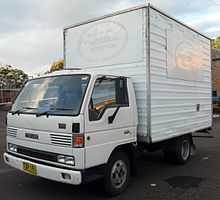
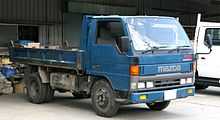
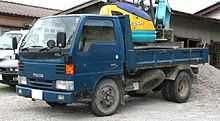
The third generation Titan was announced in 1989. The car received all-new bodywork, albeit still rather similar looking. The biggest difference is that the side windows received a pronounced dip at the leading edge, to allow the driver better visibility. The "Titan" logos were changed to all-caps. The new Titan also received mudguards, with prominent "Titan" script. In 1992 the Titan underwent a minor facelift, softening the design somewhat.
In 1995 there was another facelift, although there were also some mechanical changes this time: To be compliant with the stricter 1994 emissions standards, Mazda had to replace the higher output engines with Isuzu's 4HF1 and 4HG1 engines. The Mazda logo was made considerably larger.
In October 1997 there was another modernization. The front was rounded off, with the windscreen made to look larger by placing a piece of black plastic beneath it. The four square lamps were replaced by more irregularly shaped single units which wrap around the corners. The Titan logo was changed from red to white characters.
In May 1999, the 1998 emissions standards were met - except for the four-litre version, which did not become compliant until November.
In export markets, the Titan was sold as the "Mazda T Series" and "Ford Trader". Buyers had a choice of rear ends that included ute bed, tray top, and a box which included a hydrological lifting tray. The choice of motor was either a four or six-cylinder diesel (some of which are of Perkins origins) or a petrol engine with either four or six cylinders.
Fourth generation (2000–2004)
2000 May: 4th release.
October 2000: 1t payload featuring Bushido class (with which Bongoburonyi truck was discontinued.)
November 2000: CNG vehicles added.
June 2004: Titan (1.5-4t car) the fifth (of the Isuzu Elf OEM) transition. Bushido only continue production (Production Stamping commissioned.)
December 2004: New diesel regulations compatible short. All models driver's seat airbags are standard equipment.
August 2007: New long-term regulatory compliance.
August 2010: The Bushido was discontinued.
Fifth generation (2004–2007)
In June 2004 the lighter Bushido became the only truck to be built in-house by Mazda, as the fifth generation Titan was an OEM-supplied Isuzu Elf. The fourth was the last own-developed 1.5-4t truck, and saw an uncommonly short production run of only four years - the model life of a truck in the Japanese market usually being around 10 years.
Sixth generation (2007–present)

January 10, 2007: Remodeled, Isuzu Elf 6-generation vehicle OEM supply.
References
- ↑ Ozeki, Kazuo (2007).
日本のトラック・バス 1918~1972 [Japanese Trucks and Buses 1918-1972:] (in Japanese). Tokyo: Miki Press. p. 154. ISBN 978-4-89522-494-9. - ↑ 2.0 2.1 2.2 Ozeki, p. 156
- ↑ 3.0 3.1 2トン積みトラック「E2000」発売 [Two-ton cargo truck "E2000" released] (in Japanese). Mazda Motor Corporation. Archived from the original on 12-06-2010. Check date values in:
|archivedate=(help) - ↑ 4.0 4.1 Baldwin, Nick (1981), The Observer's Book of Commercial Vehicles (#40), London: Frederick Warne, p. 117, ISBN 0-7232-1619-3
| ||||||||||||||||||||||||||||||||||||